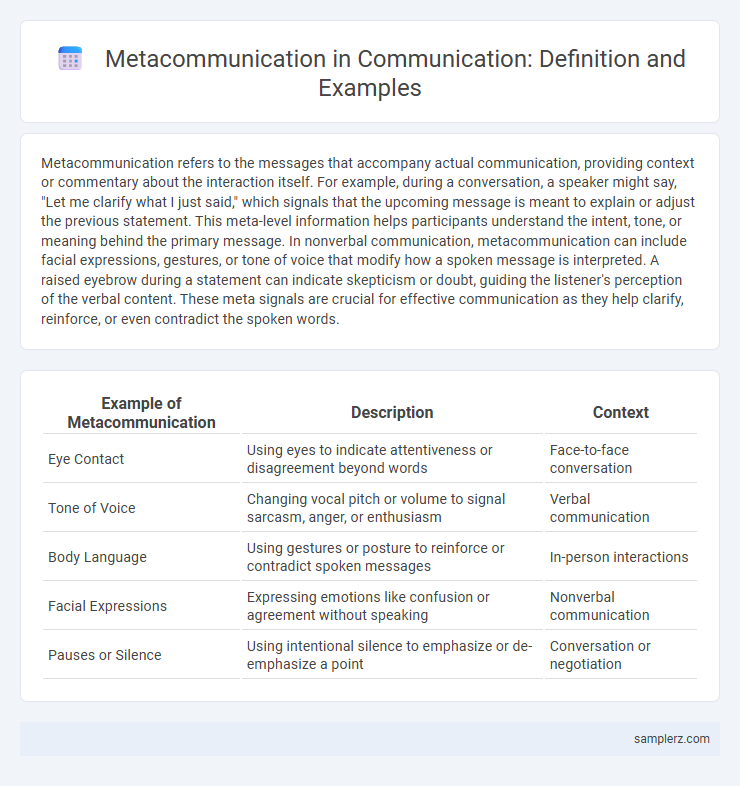Metacommunication refers to the messages that accompany actual communication, providing context or commentary about the interaction itself. For example, during a conversation, a speaker might say, "Let me clarify what I just said," which signals that the upcoming message is meant to explain or adjust the previous statement. This meta-level information helps participants understand the intent, tone, or meaning behind the primary message. In nonverbal communication, metacommunication can include facial expressions, gestures, or tone of voice that modify how a spoken message is interpreted. A raised eyebrow during a statement can indicate skepticism or doubt, guiding the listener's perception of the verbal content. These meta signals are crucial for effective communication as they help clarify, reinforce, or even contradict the spoken words.
Table of Comparison
| Example of Metacommunication | Description | Context |
|---|---|---|
| Eye Contact | Using eyes to indicate attentiveness or disagreement beyond words | Face-to-face conversation |
| Tone of Voice | Changing vocal pitch or volume to signal sarcasm, anger, or enthusiasm | Verbal communication |
| Body Language | Using gestures or posture to reinforce or contradict spoken messages | In-person interactions |
| Facial Expressions | Expressing emotions like confusion or agreement without speaking | Nonverbal communication |
| Pauses or Silence | Using intentional silence to emphasize or de-emphasize a point | Conversation or negotiation |
Defining Metacommunication in Human Interaction
Metacommunication in human interaction refers to the underlying message conveyed through tone, body language, or context that shapes how verbal communication is interpreted. For example, a smile paired with a simple "thank you" signals sincerity and warmth beyond the literal words. Understanding metacommunication enhances clarity and reduces misunderstandings by highlighting the relational and emotional layers of communication.
The Role of Metacommunication in Effective Communication
Metacommunication plays a crucial role in effective communication by providing clarity about the communication process itself, such as signaling tone, intention, or emotional state. For example, saying "I'm joking" after a potentially ambiguous statement helps prevent misunderstandings and aligns participants' interpretations. This form of communication enhances mutual understanding and reduces conflict by explicitly addressing how messages should be received.
Nonverbal Cues as Metacommunication Examples
Nonverbal cues such as facial expressions, gestures, and body posture serve as powerful examples of metacommunication, providing context and emotional tone beyond spoken words. Eye contact can signal attention or discomfort, while a crossed-arm stance might indicate defensiveness, influencing the interpretation of the verbal message. These nonverbal signals guide the receiver's understanding and regulate the flow of interaction, enhancing overall communication effectiveness.
Paralinguistic Signals and Their Metacommunicative Functions
Paralinguistic signals such as tone of voice, pitch, and pause duration function as key metacommunicative tools by conveying emotions and attitudes beyond spoken words. Variations in voice intonation can indicate sarcasm, seriousness, or uncertainty, helping listeners interpret the intended meaning accurately. These vocal cues regulate conversational flow and clarify the speaker's intent, enhancing overall communication effectiveness.
Metacommunication in Digital Communication: Emojis and Beyond
Metacommunication in digital communication often manifests through emojis, which convey emotions and clarify tone beyond text alone, reducing misunderstandings. Beyond emojis, features like typing indicators and read receipts provide contextual cues that influence conversational dynamics and user expectations. These tools enhance message interpretation by signaling attention, engagement, and emotional nuances in digital interactions.
Cultural Variations in Metacommunication
Cultural variations in metacommunication significantly influence how messages are interpreted beyond spoken words, with differences in nonverbal cues such as eye contact, gestures, and silence shaping the meaning in diverse cultural contexts. For instance, in East Asian cultures, prolonged silence during conversation is often a sign of respect and contemplation, whereas in Western cultures, it may be perceived as awkward or disengagement. Understanding these cultural metacommunicative signals is essential for effective cross-cultural communication and minimizing misunderstandings.
Impact of Metacommunication on Conflict Resolution
Metacommunication, such as clarifying tone or intent during a disagreement, significantly reduces misunderstandings in conflict resolution by making implicit messages explicit. Explicitly discussing communication patterns allows parties to address underlying emotional cues and avoid escalation. This process improves empathy and trust, leading to more effective and lasting conflict resolution.
Common Metacommunicative Mistakes and Misinterpretations
Misinterpretations of metacommunication often arise when nonverbal cues contradict spoken words, leading to confusion and mistrust. Common mistakes include ambiguous tone of voice or unclear body language that can signal sarcasm or disinterest unintentionally. Effective metacommunication requires consistent alignment between verbal messages and nonverbal signals to prevent misunderstandings in interpersonal communication.
Enhancing Relationships through Conscious Metacommunication
Metacommunication involves discussing the communication process itself to clarify intentions, resolve misunderstandings, and strengthen emotional connections, such as saying, "I feel unheard when you interrupt." This conscious approach fosters mutual awareness and empathy, improving trust and collaboration in relationships. Research in interpersonal communication highlights that metacommunication reduces conflicts and enhances relational satisfaction by aligning verbal and nonverbal messages.
Everyday Life Scenarios Illustrating Metacommunication
In everyday life, metacommunication occurs when a person clarifies their tone during a conversation, such as saying, "I'm joking" after a sarcastic comment to prevent misunderstandings. Couples often use metacommunication to discuss how they communicate, improving emotional connection by addressing feelings about the conversation itself. Family members might engage in metacommunication by explicitly stating when they need to pause a discussion to avoid escalating conflict, highlighting the importance of managing communication dynamics.

example of metacommunication in communication Infographic
 samplerz.com
samplerz.com